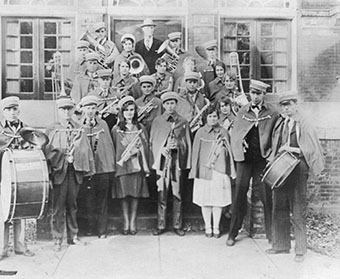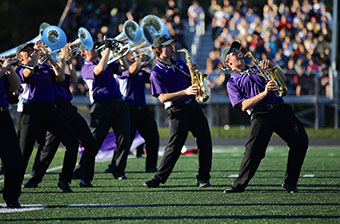Then and Now: Marching Band
by Greg Kassen ’18
In the Centennial History of McKendree College, there contains a story of a great football game played in the year 1902. More than
600 visitors came to the field that day and, to welcome in the masses, what would
be known as “yell leaders” accompanied a brass band and drum corps in celebration.
By all accounts, this is the earliest mention of any form of pep band listed in McKendree’s
history.
It was not until over 20 years later, in the 1925–1926 school year, that McKendree
would get a proper band on the field. Starting with 15 men leading the crowd, the
band played for many years, adding new male and female performers and participating
in events such as football and basketball games, parades, and special occasions on
campus. The band was not a constant presence at McKendree, though, suspending activities
for a few years at a time until, in the late 50s, it disbanded for around 40 years.
During the break, the music department continued without a marching band, instead opting to promote a variety of ensembles
and concert bands. This was the case until the marching band was brought back under
the direction of David Boggs, who leads it today. “We started off with 13 members
in the fall of 1999 and played up in the stands at football and basketball games,”
he recalled.
Through the early resurrection years, David worked to build the reputation of the
Marching Bearcat Band, reaching out to band directors and working with high school bands in clinic settings.
“We created a number of educational programs for directors to bring their students
on campus so that they could experience firsthand what the McKendree music experience
was like.”
His work has paid off, as membership climbed to 70-plus as of 2017 and the band is
known in southern Illinois as an outstanding and very entertaining ensemble.

The band, circa 1931.

The Marching Bearcat Band performs the “Bearcat Boogie” on the football field.

